
The brown-tail moth is a moth of the family Erebidae. It is native to Europe, neighboring countries in Asia, and the north coast of Africa. Descriptions of outbreaks, i.e., large population increases of several years duration, have been reported as far back as the 1500s. The life cycle of the moth is atypical, in that it spends approximately nine months as larvae (caterpillars), leaving about one month each for pupae, imagos and eggs. Larvae (caterpillars) are covered in hairs. Two red spots on the back, toward the tail, distinguish these species from other similarly hairy moth larvae. The winged adults have white wings and a hairy white body with a tuft of brown hair at the tip of the abdomen. Females lay one egg cluster, usually on the underside of a leaf of a host plant. The species is polyphagous, meaning that it feeds on many different species of trees, including pear, apple, maple and oak.
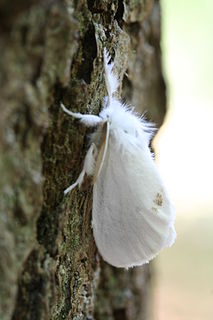
The yellow-tail, goldtail moth or swan moth is a moth of the family Erebidae. The species was first described by Johann Kaspar Füssli in 1775, and has commonly been placed within the related genus Euproctis. It is distributed throughout Europe to the Urals, then east across the Palearctic to Siberia and south to India and Sri Lanka.
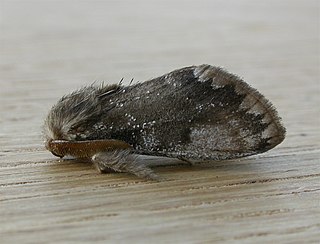
Euproctis marginalis, the margined browntail moth, is a moth of the family Erebidae. The species was first described by Francis Walker in 1855. It is found in Australia, including Tasmania.
Epeuproctis is a monotypic moth genus in the family Erebidae. Its only species, Epeuproctis tamahonis, is found in Taiwan. Both the genus and species were first described by Shōnen Matsumura, the genus in 1933 and the species in 1927.

Euproctis is a genus of tussock moths in the family Erebidae described by Jacob Hübner in 1819. Species are cosmopolitan, widespread throughout Palearctic, African, Oriental and Australian regions. Molecular phylogenetic studies indicate that the genus as presently understood comprises a large number of unrelated lineages, only a few of which have names, and is therefore in serious need of revision.

Sphrageidus is a genus of tussock moths in the family Erebidae. It is considered a synonym of the related genus Euproctis by some authors, but still recognized as valid by others (e.g.), and supported as distinct in molecular phylogenetic studies.
Somena exigua is a moth in the family Erebidae. It was described by John Nietner in 1861. It is found in Sri Lanka.
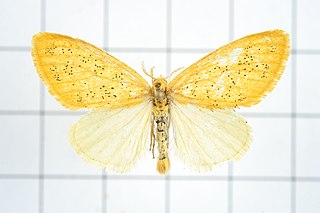
Euproctis pulverea is a moth of the subfamily Lymantriinae first described by John Henry Leech in 1888. It is found in Japan, Korea and Taiwan.
Euproctis bimaculata is a moth of the family Erebidae first described by Francis Walker in 1855. It is found in India, Sri Lanka and Thailand.
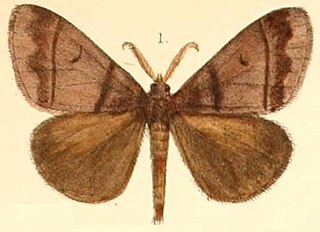
Euproctis cervina is a moth of the family Erebidae first described by Moore in 1877. It is found in Sri Lanka.
Euproctis fraterna is a moth of the family Erebidae first described by Moore in 1883. It is found in the Maldives, India, Sri Lanka and the Seychelles.
Euproctis fulvipuncta is a moth of the family Erebidae first described by George Hampson in 1893. It is found in India and Sri Lanka.
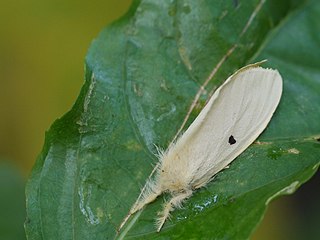
Euproctis lunata, the castor hairy caterpillar, is a moth of the family Erebidae. The species was first described by Francis Walker in 1855. It is found in India, Pakistan, Sri Lanka and Thailand.

Euproctis latifascia is a moth of the family Erebidae first described by Francis Walker in 1855. It is found in India, Sri Lanka and Taiwan.
Euproctis rhoda is a moth of the family Erebidae first described by Moore in 1879. It is sometimes classified as a subspecies of Euproctis howra. It is found in India, Sri Lanka, Myanmar, the Andaman Islands and Australia.
Euproctis semisignata is a moth of the family Erebidae first described by Francis Walker in 1865. It is found in India and Sri Lanka.

Euproctis varians is a moth of the family Erebidae first described by Francis Walker in 1855. It is found in India, Sri Lanka, the Maldives, Celebes and China.
Kidokuga is a genus of tussock moths in the family Erebidae. The genus was erected by Yasunori Kishida in 2010. It is considered a synonym of the related genus Euproctis by some authors, but recognized as valid by others (e.g.), and supported as distinct in molecular phylogenetic studies.









